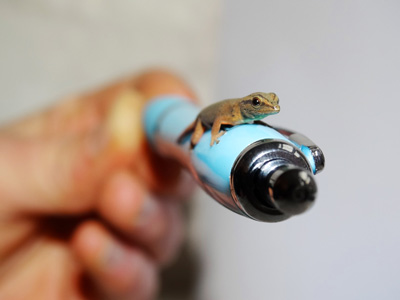The annual animal stocktake at Cotswold Wildlife Park

Each year, every zoological collection in Britain undertakes a substantial and essential task – the yearly animal count. Keepers at Cotswold Wildlife Park have just completed their annual stocktake; a compulsory requirement for all British zoos in order to keep their zoo licence. The numbers are no surprise to the Park’s keepers, as they know exactly how many animals are in the collection from their daily checks. But, once a year, the total number of mammals, birds, amphibians, fish and reptiles are officially recorded and added to the Park’s Zoological Information Management System (ZIMS). This information is shared with other zoological collections and is vital for zoo management and future international breeding programmes.
Methods used to count the 1699 individual animals from 252 different species (an 11% increase from last year) vary greatly, depending on the size, agility and natural behaviour of each animal. Larger species such as the Giraffes, Lions and Rhinos are straightforward to record, but smaller, more agile or shyer species require different tactics. Creatures particularly adept at camouflage can present their own challenges for the annual count.
Primate keeper, Shanti Persaud, uses a particular technique to tempt the Park’s notoriously secretive pair of Linne’s Two-toed Sloths to come out of hiding. As they are perfectly camouflaged amongst the natural flora of the Tropical House, locating their whereabouts can take time. She attaches one of their favourite foods to the end of a bamboo stick (pictured right). Keen to taste the delicious grapes, the Sloths eventually emerge from their hiding places, allowing Shanti to carry out her essential daily animal health checks and confirm their numbers for the census.
Quick moving mammals such as the Mouse Lemurs (one of the smallest primates in the world), Bats and Naked Mole Rats provide a different challenge when it comes to the animal count. Primate Section Head, Chris Kibbey, explains: “Animals like the Naked Mole Rats can prove problematic. They are tricky to count when busily running along their Perspex tubing system (scurrying backwards as well as forwards, as they would in their underground tunnels in the wild). Even when resting, they huddle in a large pile in one of their nest chambers, clambering on top of one another, making it difficult to count accurately. During a recent spring clean, we counted all of the Mole Rats individually when they were carefully moved into a warm box to maintain their delicate body temperature. This enabled us to ensure that the number of animals corresponded with the number on the inventory.”
Counting underground dwellers such as the Prairie Dogs requires a keen eye, as they rarely remain still and speedily disappear into their burrows. Primate Keeper, Natalie Horner, comments: “Counting our town of Black-tailed Prairie Dogs is no easy task. The enclosure is designed to resemble their natural habitat of the grasslands of North America where they live in extensive underground burrow systems. Unable to see into their burrows, the only way we can view our Prairie Dogs is when they are on the surface. Rarely will they all be above ground at any one time, making an accurate count very difficult to achieve. Over the course of a few days, at several points throughout the day, we count all the Prairie Dogs above ground level, giving us an average and maximum number of animals on show. This sounds simple enough, but can turn into quite a feat with one individual disappearing down a burrow hole and appearing at another, all the while not knowing for sure if it was actually the same individual you just saw retreating down said burrow! All-in-all though, with a little patience, we were able to achieve an accurate total number of animals within the group.”
Other notable additions included in the latest animal count:
- The birth of two Rhino calves in 2015. The newest arrival was named John in memory of the founder of Cotswold Wildlife Park - Mr John Heyworth. Mr Heyworth opened the Park in 1970. A forty-three year wait ensued before the Rhinos successfully produced their first calf in 2013.
- The Park’s first successful breeding of three Critically Endangered Electric Blue Geckos (one pictured top left). These tiny creatures are only found in an 8km square region of the Kimboza Forest in Tanzania, within which they exclusively dwell in the leaf of the crowns of one specific tree (Pandanus rabaiensis).
- A chick produced by the oldest Humboldt Penguin in the collection - twenty-three year old Mushy. She amazed keepers by producing yet another chick last year – a remarkable achievement at her age.
- The first successful breeding of a brand new species for the Reptile section – Vietnamese Mossy Frogs. The froglets are developing well and more tadpoles have been discovered by keepers. This new species will hopefully go on show to visitors later in 2016.
Explore Gloucestershire
29 January 2016
For further information.
OTHER NEWS
